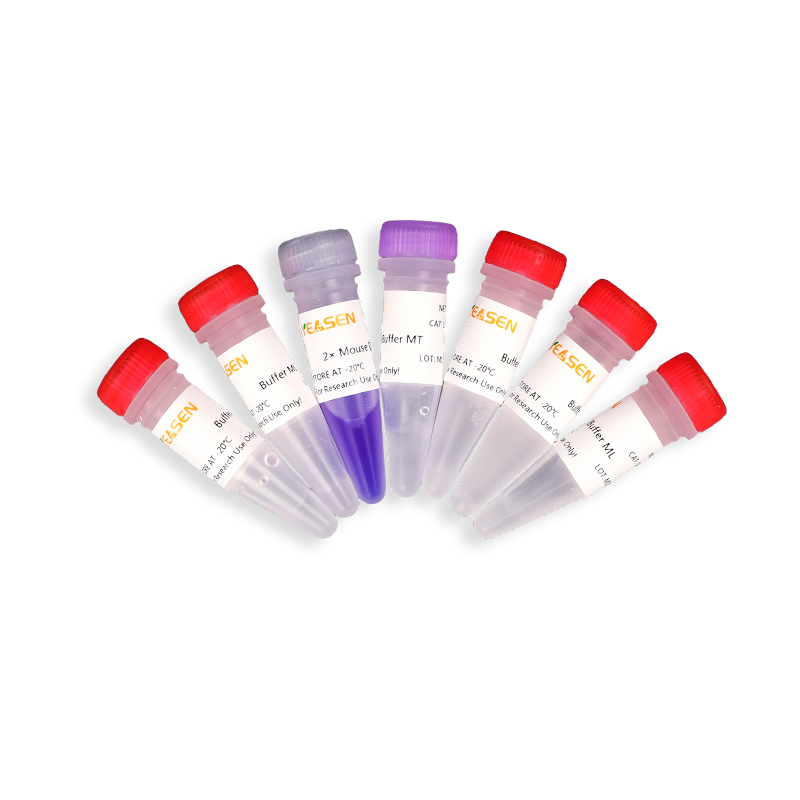Mouse Tissue Direct PCR Kit (With Dye)
Description
This kit can directly and quickly conduct PCR amplification of mouse tissue (such as mouse tail, mouse ear, mouse toe, muscle, etc.), and has strong sample compatibility. Equipped with a powerful lysis buffer, this kit can rapidly lyse samples and release genomic DNA. The lysate can be directly added to the PCR reaction system without purification, and the operation is convenient. In addition, this kit requires low sample input, and 5 mg mouse tissue or 1-5 mm mouse tail can be used for experiments.
The 2× Mouse Direct PCR Mix provided by this kit is a hot-start PCR reaction solution with a 2-fold concentration. It contains all the components used for PCR amplification except the template and primers, which greatly simplifies the operation process and reduces the chance of contamination. The kit can be used for transgene identification, mouse genotyping, etc.
Features
- Less sample required: 5 mg of mouse tissue or 1-5 mm of mouse tail
- Convenient template preparation: no need to grind, no need to refine and purify DNA, higher flux, time and money saving
- Optimized PCR system: with higher specificity and stronger tolerance of PCR reaction inhibitor
Applications
- Identification of transgenic mice
- Genotyping of mice
- Mouse gene knockout analysis
Specifications
|
Product specification |
Kit |
|
Hot start |
Built-in Hot Start |
|
Conditions for transportation |
Ice Packs |
|
Product type |
Direct PCR Kit |
|
Apply to (application) |
Mouse tail, Mouse ear, Rat toe, Viscera, Skin, etc. |
Components
|
Components No. |
Name |
10185ES50 |
10185ES70 |
|
10185-A |
Buffer ML |
5×1 mL |
20×1 mL |
|
10185-B |
Buffer MT |
0.6 mL |
2×1.25 mL |
|
10185-C |
2× Mouse Direct PCR Mix |
500 μL |
2×1 mL |
a) Buffer ML is a lysis buffer containing strong protein denaturants, please wear gloves.
b) Buffer MT is a stop buffer used to stop the lysis function of Buffer ML.
c) 2× Mouse Direct PCR Mix: Contains hot-start Taq DNA polymerase, dNTP mix, MgCl2 , reaction buffer, PCR reaction enhancer, optimizer, stabilizer, electrophoresis indicator dye, etc.
Storage
1. Component A: The product should be stored at 2°C~8°C for one year. For multiple use for a long time, please avoid cross-contamination.
2. Component B/C: The product should be stored at -25℃ ~ -15℃ for one year. Please avoid repeated freeze-thaw.
Figures
1. Target gene (within 1 kb) amplification result

Figure 1. Suitable for target gene amplification within 1 kb.
2. The extension speed demostration

Figure 2. 500bp gene, the extension speed can be as fast as 1sec/kb.

Cited from "TFPI is a colonic crypt receptor for TcdB from hypervirulent clade 2 C. difficile. Cell . 2022 Mar 17;185(6):980-994.e15. doi: 10.1016/j.cell.2022.02.010. "
|
Common problem |
Possible reason |
Solution |
|
There were no bands in the positive control and the samples to be tested. |
The PCR reaction system or reaction conditions were not suitable. |
Use gradient PCR to explore the optimal reaction conditions for PCR. |
|
Improper storage of PCR reagents loses activity. |
2× Mouse Direct PCR Mix should be stored at -20°C and avoid repeated freezing and thawing during use. If used frequently, it can be stored at 4°C for a short time. |
|
|
Primer design issues. |
Try redesigning the primers to check. |
|
|
The positive control has a band of interest, and the sample to be tested has no band or a weak band. |
Improper storage or prolonged storage can cause loss of reagent activity. |
Use fresh reagents. |
|
Add tissue lysate in excess. |
Increase the reaction system, or reduce the amount of lysate. |
|
|
The sample lysis mixture has been stored improperly or stored for too long, and the DNA genome has been degraded. |
The lysate mixture can be stored at 4°C for 2-3 days. Try to use a freshly prepared lysate mixture for PCR. |
|
|
The amount of template added is not suitable. |
The amount of template added was optimized within the range of 1-10% of the reaction system. |
|
|
Insufficient number of PCR cycles. |
Increase the number of PCR cycles, preferably 35-40 cycles. Because of the complexity of the template, PCR reactions should be performed with 5-10 more cycles than with purified DNA template. |
|
|
Nonspecific amplification |
PCR annealing temperature too low, cycle number, primer concentration, or template concentration too high. |
Increase PCR annealing temperature and decrease PCR cycle number, primer concentration or template concentration. |
|
PCR primer mismatches. |
Redesign PCR primers. |
|
|
The temperature is too high when preparing the PCR reaction system or the time is too long after the preparation is completed. |
The preparation of the PCR reaction system is carried out at low temperature, and the PCR amplification reaction is carried out as soon as possible after the preparation is completed. |
|
|
Target band appears in negative control |
Contamination of operating tools or reagents. |
All reagents or equipment in the experiment should be autoclaved. Be careful and gentle when handling to prevent the target sequence from being sucked into the sample gun or spilled out of the centrifuge tube. |
|
Cross-contamination between samples. |
Each sampler is only used for one sample; or after taking one sample, immerse the edge of the sampler in 2% sodium hypochlorite solution, rinse repeatedly, and then dry the residue with a clean paper towel. |
[1] Luo J, Yang Q, Zhang X, et al. TFPI is a colonic crypt receptor for TcdB from hypervirulent clade 2 C. difficile. Cell. 2022;185(6):980-994.e15. doi:10.1016/j.cell.2022.02.010(IF:41.584)
[2] Zhao J, Chen J, Li YY, Xia LL, Wu YG. Bruton's tyrosine kinase regulates macrophage‑induced inflammation in the diabetic kidney via NLRP3 inflammasome activation. Int J Mol Med. 2021;48(3):177. doi:10.3892/ijmm.2021.5010(IF:4.101)
Catalog No.:*
Name*
phone Number:*
Lot:*
Email*
Country:*
Company/Institute:*
Related articles

